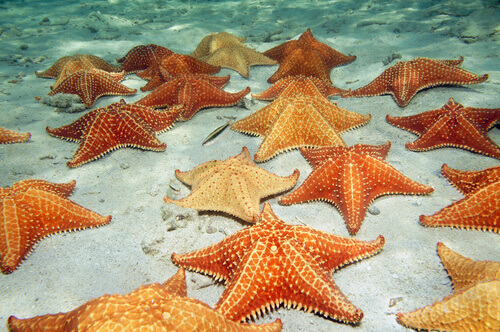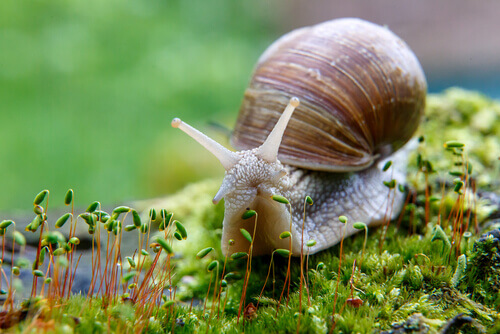The Evolutionary Meaning of Being a Hermaphrodite


Written and verified by the biologist María Muñoz Navarro
Hermaphrodite beings are those that produce male and female gametes. This situation is widespread in most plants, but did you know that hermaphroditism also occurs in animals? Here, we’ll show you why being a hermaphrodite can be an evolutionary advantage in the animal kingdom, along with some examples.
Reproductive systems
In nature, there are many different methods of reproduction. These have varied throughout history, according to the evolutionary advantages that they provide to each species, whether plants, animals, or fungi.
There are two general reproduction systems:
- Separate sexes or dioecia. This is when there are male beings and female beings.
- Hermaphroditism. This is characterized by the presence of male and female reproductive organs in the same being.

Advantages of being a hermaphrodite
Sex assignment theory holds that hermaphroditism is favored by natural selection when the number of offspring is greater in hermaphrodites than in populations where the sexes are separate.
According to a study in the Journal of Evolutionary Biology, for mating to occur, animals must move about in search of their mate. If an organism lives fixed to a structure without any mobility, such as corals or mussels, finding another being to reproduce with is a challenge.
On the other hand, it’s also difficult in cases where individuals actively search for a partner because this has a high cost in terms of energy. Therefore, these animals have to manage the cost of time and energy to look for both food and a partner.
Animals can find a mate while they feed, but if they focus only on finding a mate, food is put on the back burner.
Hermaphrodites are self-sufficient
There are some hermaphrodites that self-fertilize so they don’t need another being to reproduce with, but these beings are rare.
However, the rest of the hermaphrodites can mate with any individual they meet while organisms with separate sexes need another animal of the opposite sex. Therefore, hermaphroditism is an advantage in these circumstances.
On the other hand, when mating is efficient in terms of energy, hermaphroditism is not a good breeding strategy. In these cases, natural selection comes into play so that these species end up with separate sexual organs.
Hermaphroditism is also useful when population density is very low, due to the scarcity of individuals.
Being a hermaphrodite: Types of hermaphroditism
Hermaphrodites produce both male and female gametes. However, the circumstances in which they fertilize themselves are specific.
The amount and type of gametes will depend on what best suits the physical needs of the animal.
Therefore, depending on how they manage the number of sex cells, there are two types of hermaphroditism: simultaneous and sequential.
However, some species can alternate between the two types. This will depend on:
- Competition for mating
- Population size
- The proportional relationship between the sexes
Simultaneous hermaphroditism
Animals that practice simultaneous hermaphroditism are those that, when they find a mate, can act as both a male and a female.
The ability to choose to act as one sex or another can generate conflict, as both individuals will choose the one that is easier.
Sequential hermaphroditism
In this case, the animal itself changes sex throughout their life. They begin with one type and end up with the other. This sex change has been programmed into the genes and is determined by the environment itself.
Being a hermaphrodite: Hermaphrodite animals
Hermaphroditism occurs in invertebrate animals and fish. These are some examples:
Clownfish
These creatures experience sequential hermaphroditism. Clownfish are born as males, but, eventually, they change sex and become female.
They also undergo this change when the females of the group die. This is a method of maintaining the population. All these changes are regulated by hormonal expressions.
Being a hermaphrodite: Snails
Snails are a classic example of hermaphroditism. They produce both male and female gametes. However, they don’t have the ability to self-fertilize. So, when they mate with their partner, one is the male, and the other is the female.

Starfish
Although there are male and female starfish, some species are simultaneous hermaphrodites and others are sequential hermaphrodites.
It all depends on reproductive success
Hermaphroditism, or gender separation, in one species occurs depending on reproductive success. Population density, energy costs, and capacity for movement are the factors that most influence the existence of one type of reproduction system of another.
Finally, we can conclude that low population density and slow movement favor hermaphroditism. On the other hand, if there’s a population made up of a large number of individuals that can all move efficiently, the separation of the sexes is more favorable.
Concerning the last argument, many scientists affirm that the separation of the sexes results from hermaphroditism.
All cited sources were thoroughly reviewed by our team to ensure their quality, reliability, currency, and validity. The bibliography of this article was considered reliable and of academic or scientific accuracy.
- Singh, Pragya, and Lukas Schärer. “Evolution of sex allocation plasticity in a hermaphroditic flatworm genus.” Journal of Evolutionary Biology (2022).
- Chasnov, J. R. “The evolution from females to hermaphrodites results in a sexual conflict over mating in androdioecious nematode worms and clam shrimp.” Journal of evolutionary biology 23.3 (2010): 539-556.
- Eppley, S.M. and Jesson, L.K. Moving to mate: the evolution of separate and combined sexes in multicellular organisms. J-Evol. Biol. (2008) 21(3):727-736.
- Kebir, A., Fefferman, N.H., and Ben, M.S. Understanding hermaphrodite species through game theory. J. Math. Biol. (2015) 71(6-7):1505-1524.
- Puurtinen, M. and Kaitala, V. Mate-search efficiency can determine the evolution of separate sexes and the stability of hermaphroditism in animals. Am. Nat. (2002) 160(5):645-660.
This text is provided for informational purposes only and does not replace consultation with a professional. If in doubt, consult your specialist.